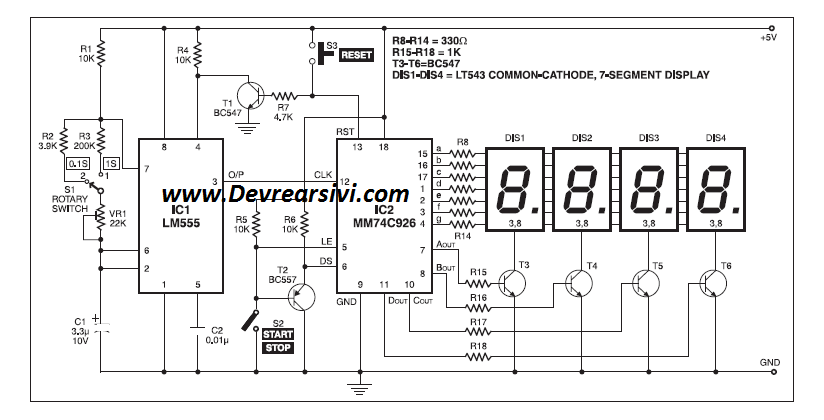DIGITAL STOP WATCH

Here’s a digital stop watch built
around timer IC LM555 and 4-digit
counter IC with multiplexed 7-segment
output drivers (MM74C926).
IC MM74C926 consists of a 4-digit
counter, an internal output latch, npn
output sourcing drivers for commoncathode,
7-segment display and an
internal multiplexing circuitry with four
multiplexing outputs. The multiplexing circuit
has its own free running oscillator,
and requires no external clock. The
counter advances on negative edge of
the clock. The clock is generated by timer
IC LM555 (IC1) and applied to pin 12
of IC2.
A high signal on reset pin 13 of
IC2 resets the counter to zero. Reset pin
13 is connected to +5V through reset
C.H. VITHALANI push-on-switch S3. When S2 is momentarily
pressed, the count value becomes
0, transistor T1 conducts and it resets
IC1. Counting starts when S2 is in ‘off’
condition.
A low signal on the latch-enable input
pin 5 (LE) of IC2 latches the number in
the counter into the internal output latches.
When switch S2 is pressed, pin 5 goes
low and hence the count value gets stored
in the latch. Display-select pin 6 (DS) decides
whether the number on the counter
or the number stored in the latch is to be
displayed. If pin 6 is low the number in
the output latch is displayed, and if pin 6
is high the number in the counter is displayed.
When switch S2 is pressed, the
base of pnp transistor T2 is connected to
ground and it starts conducting. The emitter
of T2 is connected to DS pin of IC2.
Thus, when switch S3 is pressed, reset
pin 13 of IC2 is connected to ground
via transistor T1 and the oscillator does
not generate clock pulses. This is done
to achieve synchronisation between IC1
and IC2.
First, reset the circuit so that the display
shows ‘0000.’ Now open switch S2
for the stop watch to start counting the
time. If you want to stop the clock, close
switch S2.
Rotary switch S1 is used to select the
different time periods at the output of the
astable multivibrator (IC1). The circuit
works off a 5V power supply. It can be
easily assembled on a general-purpose
PCB. Enclose the circuit in a metal box
with provisions for four 7-segment displays,
rotary switch S1, start/stop switch
S2 and reset switch S3 in the front panel
of the box.




